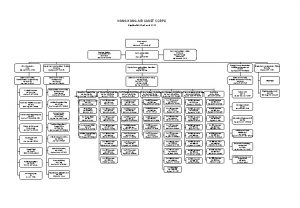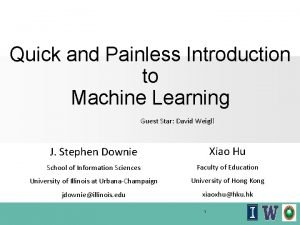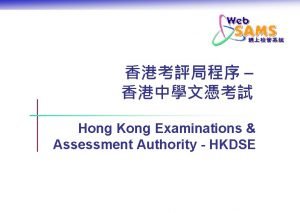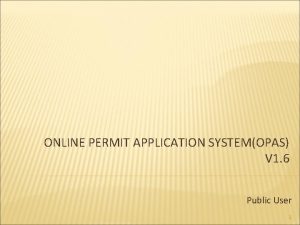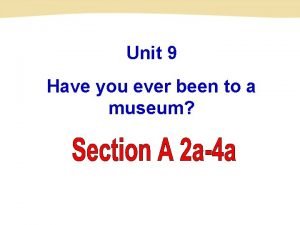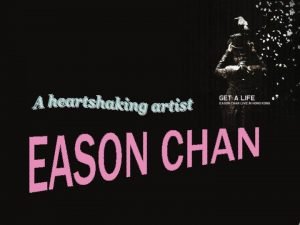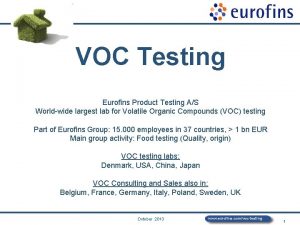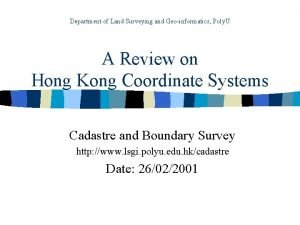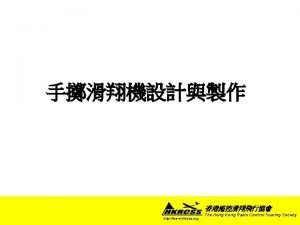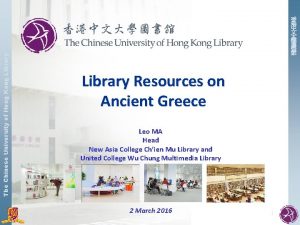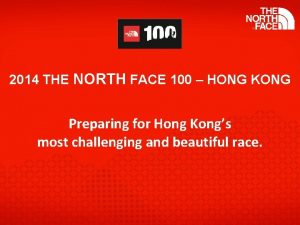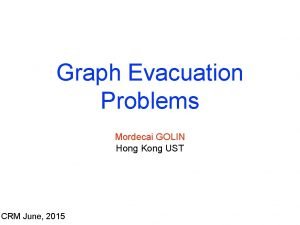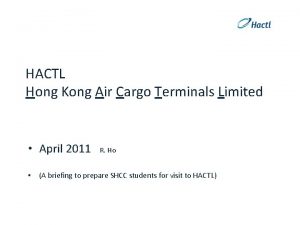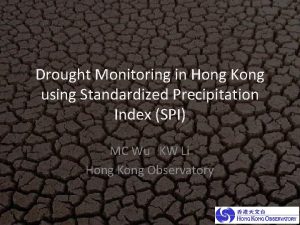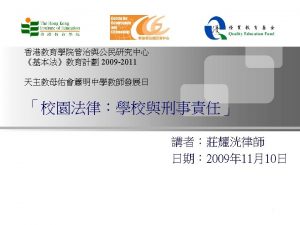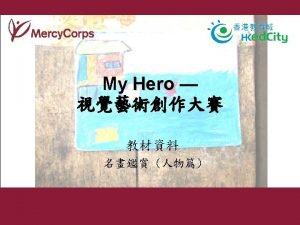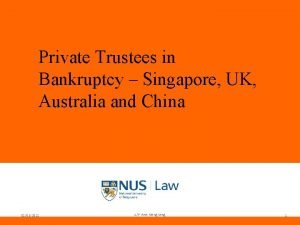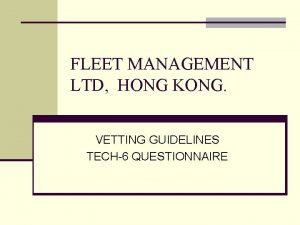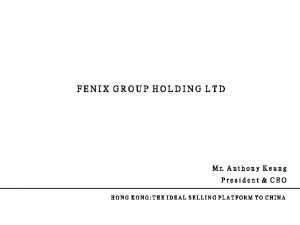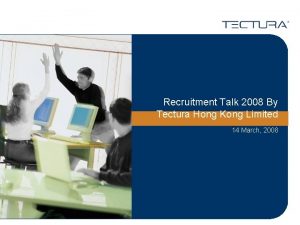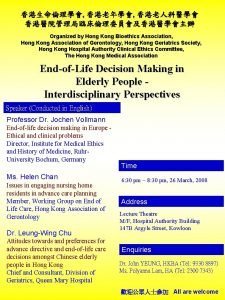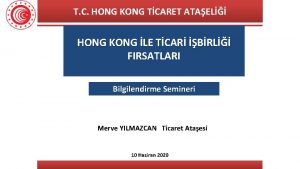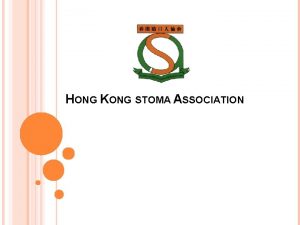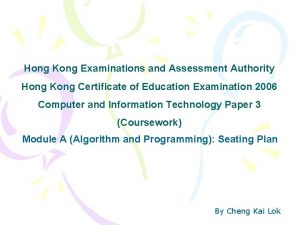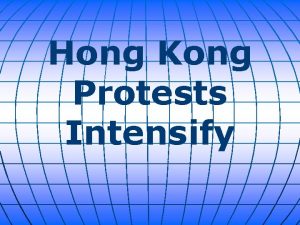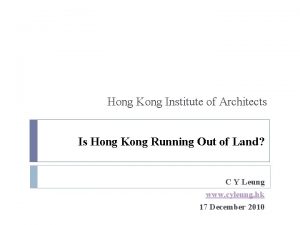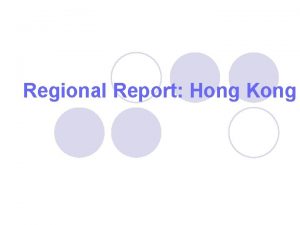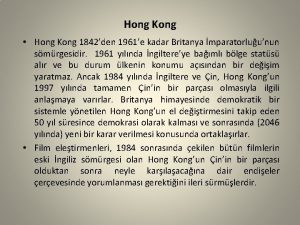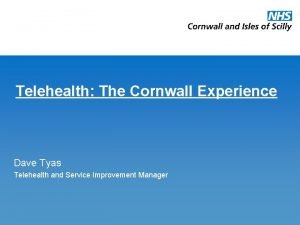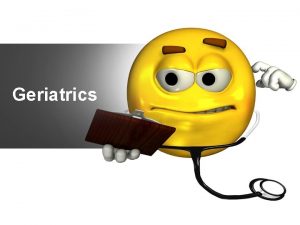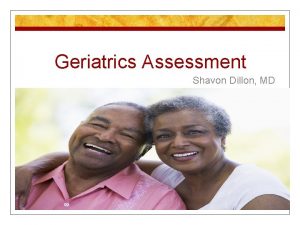Telehealth in Geriatrics A Hong Kong Experience Elsie




















































- Slides: 52

Telehealth in Geriatrics: A Hong Kong Experience Elsie Hui, FRCP Division of Geriatrics, The Chinese University of Hong Kong 1

Overview of presentation • Electronic patient record • Community Health Call Centre • Telemedicine in Geriatrics 2

Telemedicine (telegeriatrics) – what is it and why? Telephone/ Fax Traditional consultation Patient Isolation Frailty E-mail Photos & X-rays, video clips Health care provider Limited resources Traveling time Internet Health web sites, on-line assessment / education Hardware I. T. hardware Broadband 3&4 G Video-conference Real-time, audiovideo link 3

Hong Kong Special Administrative Region, People’s Republic of China • • • 7. 8 million people 1104 m 2 Urban 95% Chinese GDP per capita US$31757 (8 th in world) Gini coefficient 53. 3 4

STRUCTURE OUTCOMES HK Healthcare • Life expectancy: – years for men – years for women • Infant mortality rate: – per 1000 live births • Total Health Expenditure – As % of GDP – HK$ Primary Care 24% 20% HK UK OZ US 78. 6 84. 6 76. 6 80. 2 75. 4 82. 0 74. 1 79. 5 5. 4 5. 6 5. 7 6. 9 5. 3 67. 9 B 6. 2 7. 8 14. 8 Secondary & Tertiary 7% Long Term Care 100% 93% 56% Hospital Authority Private Traditional Chinese Medicine 5

HK Public Healthcare – serves vast majority of elderly HK$32 B Expenditure in Public Sector is 47% of the Total and 12. 2% of Government Budget Public Health and Screening Services Hospital: Specialist Clinics, and General Outpatient Clinics 6

Hospital Authority q Established 1991 q 42 Public Hospitals q 43 Specialist Outpatient Clinics (SOPD) q 74 General Outpatient Clinics (GOPC) q 28, 000 Beds q 52, 500 Staff q 19, 300 Nurses q 4, 900 Doctors q HK$28 b Annual Operating Budget (~US$4 billion) q q 5, 3 m GOPC Attendances 8, 3 m SOPD Attendances 2, 1 m A&E Attendances 1, 1 m Inpatient Discharges 7

Clinical Systems in HA ü Comprehensive functionality developed in-house since early 90’s ü High utilization by Clinicians ü Mission Critical Systems ü Increasing Strategic Importance 8

Evolution of Clinical IT Systems • • • 1990 – “Green fields” 1991 – Patient Administration 1992 – Pharmacy system 1993 – Lab results online 1994 – Radiology information system 1995 – Clinical Management System (CMS Phase I) 2000 – CMS Phase II 2002 – Electronic Patient Record System (e. PR) 2003 – e. SARS 2004 – Image Distribution via e. PR 2006 – Sharing e. PR with Private Sector 2007+ – CMS Phase III 9

Patient Master Index - HKPMI • Using Hong Kong Identity Number (HKID #) • HKPMI, Admissions/Discharges and Appointments Booking implemented across all HA hospitals and clinics • HA HKPMI contains 8 million people’s records Uniquely identify all patients and can facilitate linking together episodes of care 10

Clinical Management System - CMS Phase I - Functions • Discharge summary • Clinician coding of diagnosis & procedure codes • Ordering of medications and laboratory tests • Retrieving laboratory and radiology results • Medication history • Electronic booking of appointments • Generate referral or reply letters and reports • Cross hospital information enquiry Phase II - Modules • Generic Clinical Requests (Order Entry) • Generic Results Reporting (Forms) • Clinical Data Framework • Outcome Documentation • Medication Decision Support • Clinical Data Analysis and Reporting • Electronic Patient Record (e. PR) 11

e. PR - Patient Summary 12

e. PR - Laboratory Results 13

e. PR - Radiology Results 14

Image Distribution via e. PR 15

Sharing HA e. PR with Private Sector Opt-In Model 16

Vision for CMS Phase III Next generation’s CMS will be a system that supports the delivery of care in the HA with tools to improve quality and reduce errors, improve efficiency, and improve overall service management, and that will be an integral part of a community wide platform for sharing electronic health data 17

CMS 3 - The Way Forward … 9 Major Priorities 4 Strategic Objectives Ø Advanced Information Architecture and Systems Architecture • Ø The Intelligent Record Ø Risk Reduction and Patient Safety Ø Closed Loop Medication Management Develop the content • Facilitate the process • Improve the outcome Ø Filmless Hospital Ø Replace Departmental Systems • Extend to the Community Ø Enhance Informational Systems Ø e. Health/ Integrating Healthcare Sectors Ø Health Informatics as a Specialty 18

e-Health - A Collaborative Effort HA Identification Record Content Terminology Professional Bodies Government Data Standard Data Security Messaging Standard International Standard Bodies Private Practitioners Private Hospitals 19

The HA Community Health Call Centre (CHCC) 20 20

What is a health call centre? • A health service that enables integrated delivery of health care for consumers using information and communications technologies that have the capacity to handle high volumes of transactions for large catchments • The range of services can include information, triage, advice, referral, counseling, assessment, intake and/or health 21 management 21

Overseas Experience • Worldwide • Australia - 3 models – National - Healthdirect Australia – Victoria – Nurse-on-call – Queensland – 13 Health • UK – NHS Direct 22 22

Objectives • Provide telephone support and enhance management for high risk elderly, chronic diseases and mental illness • Improve links between the public and primary/ community healthcare service in both the public and private sectors • Reduce avoidable A&E attendance and hospitalization • Improve access to reliable healthcare advices to promote preventive care and early intervention 23 23

Key Components Telephony and IT Systems Health Information Database HA Electronic Patient Record Clinical Governance Clinical Decision Support System Quality Management and Reporting System Workforce Management Health Service Provider Directory 24 24

HA Patient Support Call Centre in Tang Shiu Kin Hospital All round the year • Mon – Fri : 8 am to 8 pm • Sat, Sun & PH : 8 am to 4 pm 25 25 25

Workflow of Call Centre for High Risk Elderly Patients Auto-filtering for “ 65+ MED patients discharged alive with HARRPE score ≥ 0. 17” Daily list of eligible patients for CHCC follow up CHCC nurse proactively call the patient within 48 hours Target clients’ key discharge issues Physical condition Medication management Remind follow up appointment Community resources need If medical problems exist Nursing assessment based on protocols Health & care advice, refer to appropriate health & community resources Documentation of problems, protocols used and advice 26 26 26

Our powerful e. PR helps More than 10 years of Data in 8. 9 million persons 27 27

80 Clinical Protocols • Abrasions • Allergic Reaction • Altered Level of Consciousness • Ankle Problems • Anxiety • Arm/Hand Problems • Asthma • Bone, Joint & tissue Injury • Bruising • Chest Pain • Decreased general condition • Dehydration • Depression • Domestic Abuse • Eye Injury • Eye Problems • Facial Pain • Fainting • • • • • Finger & Toe Problemsv v Foot Problems v Gas/Flatulence v Head Injury v Hearing Loss v Heartbeat, Rapid v Heartbeat, Slow v Heartburn v Hoarseness v Hypothermia v Jaundice v Jaw pain v Knee Pain/Swelling v Mouth Problems v Muscle Cramps v Nausea/Vomiting Adult Neck Pain Nosebleed Refused Feeding Scabies Seizure Shoulder Pain Sore Throat Stools, Abnormal Suicide Attempt, Threat Swelling Tongue Problems Toothache Urination, Difficulty Urination, Painful Urine, Abnormal Color Vision Problems Wheezing Wound Healing & Infection 28 28

29 29

Incorporate Clinical Protocols 30 30

Service Response Backup NGOs District Elderly Care Center Volunteers Community Allied Health GOPCs Community Nursing Service GPs Hospital Service 31

Summary of High Risk Elderly Program (Full Year, Apr 2011 – Mar 2012) Total No. of successful calls made (Outbound call / Inbound call) (%) 118, 575 calls (83662 / 34913) (70. 6 % / 29. 4%) No. of outbound calls per managed discharged episode 1. 4 calls Average duration per call (min) 5 min 56 sec Average time for after call work (min) 6 min 2 sec 32 32

Evaluation Study : Results v. A&E attendances (Med) 30% v. A&E admission (Med) 28% v. Acute Patient days (Med) 22% 33

Telemedicine & Tele-rehabilitation in Elderly Care 34

Tele-geriatrics in residential care home setting • Direct care – Physician (geriatrician, primary care) – Geriatric nursing – physiotherapy & occupational therapy – podiatry • Specialist consultation – Dermatology – Psychiatry – Others (neurology, radiology …. ) 35

Our History • 1998 – 99 Pilot study – SAGE Kwan Fong Nim Chee Care & Attention Home in Shatin – Medical, nursing, psychiatry, PT, OT, podiatry, dermatology • Extension of telemedicine network – To other local residential care homes for elderly (RCHEs) – To other hospitals in New Territories and their local RCHEs – To a Home Care service provider • 2003 - 04 Community rehabilitation programmes – DM, OA, CVA, dementia, incontinence 36

NTE Geriatric Service Network • • 4 hospitals 9 RCHEs 5 elderly centres Broadband or ISDN (remote areas) • Multi-point Videoconferencing machines Also capable of connecting to anywhere in the world with an IP address and VC machine (386 kbs) 古洞 Nam Fong 廣福道 Cambridge 石湖墟 Cambridge 直街 Oi Kwan Caritas FWH C&A TPH NDH (COST Office) AHNH (COST Office) PWH CUH K SH x 2 stations (COST & 8/F) Kwan Fong C&A 積存街 Cambridge Caritas C&A HCHW ELCHK 瀝源 ME 花園城 Cambridge ELCHK 秦石 DE ELCHK 馬鞍山 DECL 37

Videoconferencing Hardware Polycom View. Station FX (HKD 75 000) Tandberg 880 (HKD 110 000) • • • Shatin Hospital Norway 768 kbps (IP/ ISDN) Multi-point (max 4) max 4 video outputs 72 o wide field of view • • • Hospital and remote sites USA 512 kbps (IP/ISDN) Multi-point (max 4) max 4 video outputs 48 o field of view 38

39

Telemedicine in rehabilitation and maintenance of chronic diseases 40

Rehabilitation programmes • Chronic conditions – – – DM dementia OA stroke incontinence • Content – – exercise education group discussion peer support • Outcomes – – objective subjective qualitative teleconferencing as medium of instruction • Role of lay personnel – staff of elderly centres – volunteers – patients 41

Shatin Hospital Telehealth headquarters ELCHK Social Services Network in Shatin C Day Care Home. Help Community Clinic A B Social Centre Day Care Home Help D E Social Centre Community Clinic Social Centre 42

Why Tele-rehabilitation? • More cost-effective – utilize community resources – multiple subjects / sites • Real-time link allows interaction – instructor - subject – subject - subject • ‘Group’ has advantages over 1: 1 intervention – CDSMP model 43

Video conferencing link 1. 5 Mbps Telemed Fibre IP Link Shatin Hospital Broadband Network 1. 5 Mbps Telemed Fibre IP Link Community centre 44

Exercise training • The whole exercise session lasted for 30 minutes. • It started with a 5 -minute warm up • 10 -minute resistance training with the use of elastic tubing (Theraband®) • Followed by a 10 -minute aerobic dance • And ended with a 5 -minute cool down or progressive muscle relaxation training. 45

Foot examination & blood sugar monitoring 46

Conclusions • Community-based group rehabilitation programs incorporating exercise prescription, education and peer support can improve patients’ physical and psychological outcomes in various common chronic diseases. • The programs should be part of a comprehensive care package offered to patients with chronic diseases. • Community centres for older persons are the ideal location for running these programs. • Teleconferencing is a feasible and acceptable means to deliver such programs, and allows health care professionals to reach out to more patients in the community. 47

Telegeriatrics publications Hui E et al. Telemedicine: A pilot study in nursing home residents. Gerontology 2001; 47: 82 -87. Chan WM et al. The role of telenursing in the provision of geriatric outreach services to residential homes in Hong Kong. J Telemed Telecare 2001; 7: 38 -46. Hui E, Woo J. Telehealth for older patients: the Hong Kong experience. J Telemed Telecare 2002; 8(suppl. 3): S 3: 39 -41. Tang WK et al. Telepsychiatry in psychogeriatric service: a pilot study. Int J Geriatr Psychiatry 2001; 16: 88 -93. Corcoran H et al. The acceptability of telemedicine for podiatric intervention in a residential home for the elderly. J Telemed Telecare. 2003; 9(3): 146 -9. 48

Tele-rehabilitation publications Telemedicine in rehabilitation Elsie Hui. In Teleneurology, 2005; Royal Society of Medicine Press Ltd. Eds. Richard Wootton & Victor Patterson DM Chan WM, Woo J, Hui E et al. A Community model for care of elderly people with diabetes via telemedicine. Applied Nursing Research 2005; 18: 77 -81 OA Wong YK, Hui E, Woo J. A community-based exercise programme for older persons with knee pain using telemedicine. J Telemed telecare 2005; 11: 310 -315 Stroke JCK Lai, J Woo, E Hui, W M Chan. Telerehabilitation – a new model for community based stroke rehabilitation. J Telemed Telecare 2004; 10: 199 -205 Dementia Poon P, Hui E, Dai D, et al. Cognitive intervention for community-dwelling older persons with memory problems: telemedicine versus face-to-face treatment. Int J Geriatr Psychiatry 2005; 20: 285 -286. Urinary incontinence Hui E, Lee PSC, Woo J. Management of urinary incontinence in older women using videoconferencing versus conventional management: a randomised controlled trial. J Telemed Telecare 2006; 12: 343 -347 49

50

Way forward? • Telehealth is an integral part of our health care system • I. T. has great potential in the care of older patients – User-friendly, cheap, accessible, consistent, adaptable • Driving forces – – – Providers Users Academics Government Industry 51

Special Acknowledgement to Dr D Dai & CHCC Team of HK Hospital Authority THANK YOU! huie@h. org. hk 52
 What are some limitations of central place theory
What are some limitations of central place theory Hong kong air cadet corps
Hong kong air cadet corps The education university of hong kong
The education university of hong kong The hong kong institute of chartered secretaries
The hong kong institute of chartered secretaries Feiertage hong kong
Feiertage hong kong Celc lutheran
Celc lutheran Hong kong institute of technology
Hong kong institute of technology Websams cdr
Websams cdr Hong kong chemistry olympiad
Hong kong chemistry olympiad Routing and switching
Routing and switching Bloomberg academy hong kong
Bloomberg academy hong kong Urban decay problem in hong kong
Urban decay problem in hong kong Ipd hong kong
Ipd hong kong Https //extranetapps.hong kong airport.com
Https //extranetapps.hong kong airport.com Hong kong institute of educational research
Hong kong institute of educational research Have you ever been to hong kong
Have you ever been to hong kong Hong kong airport advertising
Hong kong airport advertising Cantonese singers male
Cantonese singers male Hong kong private placement regulation
Hong kong private placement regulation Russian companies listed in hong kong
Russian companies listed in hong kong Eurofins product testing hong kong limited
Eurofins product testing hong kong limited Reebok hong kong
Reebok hong kong Hong kong 1980 grid system
Hong kong 1980 grid system Hong kong
Hong kong Cuhk library
Cuhk library Corporate finance law firm hong kong
Corporate finance law firm hong kong The north face 100 hong kong
The north face 100 hong kong Golin hong kong
Golin hong kong Attainment test examples
Attainment test examples Water pollution in hong kong
Water pollution in hong kong Gyeongu
Gyeongu Hkbu communication studies
Hkbu communication studies Presentiment of death by rizal
Presentiment of death by rizal Hong kong diploma of secondary education examination
Hong kong diploma of secondary education examination Hactl - hong kong air cargo terminals limited
Hactl - hong kong air cargo terminals limited Hong kong horse
Hong kong horse Types of drought
Types of drought The boys’ & girls’ club association of hong kong
The boys’ & girls’ club association of hong kong Breakfast for a sedentary worker
Breakfast for a sedentary worker Hong kong education city
Hong kong education city Hong kong certificate of education examination
Hong kong certificate of education examination Stephen cheung hong kong
Stephen cheung hong kong Currency board system
Currency board system Seng14 hong kong
Seng14 hong kong San miguel hong kong
San miguel hong kong Hong kong crowdfunding
Hong kong crowdfunding Bonus group
Bonus group Hong kong holding company
Hong kong holding company Fleet management hong kong
Fleet management hong kong Fenix group holdings ltd
Fenix group holdings ltd Career plan
Career plan One day in hong kong
One day in hong kong Hong kong budding poets (english) award online platform
Hong kong budding poets (english) award online platform

